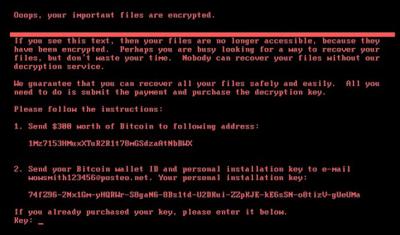Petya ransomware impacting large organisations
Petya ransomware impacting large organisations in multiple countries.

This new strain of the Petya ransomware started propagating on June 27, 2017, infecting many organisations. Similar to WannaCry, Petya uses the Eternal Blue exploit to propagate itself.
What is Petya?
Petya has been in existence since 2016. It differs from typical ransomware as it doesn’t just encrypt files, it also overwrites and encrypts the master boot record (MBR).
In this latest attack, the following ransom note is displayed on infected machines, demanding that $300 in bitcoins be paid to recover files:
How does Petya spread and infect computers?
Petya propagates itself by exploiting the MS17-010 vulnerability, also known as Eternal Blue. Symantec continues to investigate other possible methods of propagation.
Who is impacted?
At time of writing, Petya is primarily impacting organisations in Europe.
Is this a targeted attack?
It’s unclear at this time, however, previous strains of Petya have been used in targeted attacks against organisations.
Am I protected from the Petya Ransomware?
Symantec Endpoint Protection (SEP) and Norton products proactively protect customers against attempts to spread Petya using Eternal Blue. SONAR behavior detection technology also proactively protects against Petya infections. Symantec products also detect Petya components asRansom.Petya.
What are the details of Symantec's protection?
Network-based
protection
Symantec has the following IPS
protection in place to block attempts to exploit the
MS17-010 vulnerability:
• OS Attack: Microsoft SMB MS17-010 Disclosure Attempt (released May 2, 2017)
• Attack: Shellcode Download Activity (released April 24, 2017)
Antivirus
Symantec is continuing to analyze this threat and will post further information as soon as it becomes available.
ends


 Business Canterbury: Urges Council To Cut Costs, Not Ambition For City
Business Canterbury: Urges Council To Cut Costs, Not Ambition For City Wellington Airport: On Track For Net Zero Emissions By 2028
Wellington Airport: On Track For Net Zero Emissions By 2028 Landcare Research: ANZAC Gall Fly Release Promises Natural Solution To Weed Threat
Landcare Research: ANZAC Gall Fly Release Promises Natural Solution To Weed Threat NZ Anti-Vivisection Society: Auckland Rat Lovers Unite!
NZ Anti-Vivisection Society: Auckland Rat Lovers Unite! University of Canterbury: $1.35 Million Grant To Study Lion-like Jumping Spiders
University of Canterbury: $1.35 Million Grant To Study Lion-like Jumping Spiders Federated Farmers: Government Ends War On Farming
Federated Farmers: Government Ends War On Farming



